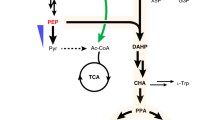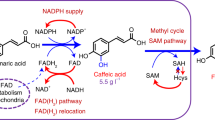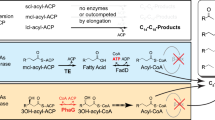Abstract
We have engineered an industrial strain of the yeast, Candida tropicalis, for the efficient production of long–chain dicarboxylic acids, which are important raw materials for the chemical industry. By sequential disruption of the four genes encoding both isozymes of the acyl–CoA oxidase which catalyzes the first reaction in the β–oxidation pathway, alkane and fatty acid substrates have been successfully redirected to the ω–oxidation pathway. Consequently, the conversion efficiency and chemical selectivity of their terminal oxidation to the corresponding dicarboxylic acids has been improved to 100 percent. The specific productivity of the bioconversion has been increased further by amplification of the cytochrome P450 monooxygenase and NADPH–cyto–chrome reductase genes encoding the rate–limiting ω–hydroxylase in the ω–oxidation pathway. The amplified strains demonstrated increased ω–hydroxylase activity and a 30% increase in productivity compared to the β–oxidation–blocked strain in fermentations. The bioconversion is effective for the selective terminal oxidation of both saturated and unsaturated linear aliphatic substrates with chain–lengths ranging from 12 carbons to 22 carbons and also avoids the undesirable chain modifications associated with passage through the β–oxidation pathway, such as unsaturation, hydroxylation, or chain shortening. It is now possible to efficiently produce a wide range of previously unavailable saturated and unsaturated dicarboxylic acids with a high degree of purity.
This is a preview of subscription content, access via your institution
Access options
Subscribe to this journal
Receive 12 print issues and online access
$209.00 per year
only $17.42 per issue
Buy this article
- Purchase on Springer Link
- Instant access to full article PDF
Prices may be subject to local taxes which are calculated during checkout
Similar content being viewed by others
References
Ogino, S., Yano, K., Tamura, G. and Arima, K. 1965. Studies on utilization of alkanes by yeasts. Part II. Diterminal oxidation of alkanes by yeasts. Agr. Biol. Chem. 29: 1009–1015.
Rehm, H.J. and Reiff, I. 1981. Mechanisms and occurrence of microbial oxidation of long-chain alkanes. Adv. Biochem. Eng. 9: 175–215.
Shio, I. and Uchio, R. 1971. Microbial production of long-chain dicarboxylic acids from n-alkanes. Fart I. Screening and properties of microorganisms producing dicarboxylic acids. Agr. Biol. Chem. 35: 2033–2042.
Hill, F.F., Venn, I. and Lukas, K.L. 1986. Studies on the formation of long-chain dicarboxylic acids from pure n-alkanes by a mutant of Candida tropicalis. Appl. Microbiol. Biotechnol 24: l68–l74.
Furukawa, T., Matsuyoshi, T. and Kise, S. 1986. Selection of high brassylic producing strains of Torulopsis, Candida by single-cell cloning and by mutation. J. Ferment. Technol. 64: 97–101.
Okino, H., Taoka, A. and Uemura, N. 1986. Production of macrocyclic musk compounds, via alkanedioic acids produced from n-alkanes. p. 753–760 In: Flavors and Fragrances: A World Perspective. Proceedings of the 10th International Conference of Essential Oils, Flavors and Fragrances. Lawrence. B. M., Mookherjee, B.D. and Willis, B.J. (E.ds.). Else-vier Science Publishers BV, Amsterdam.
Meussdoerffer, F. 1988. Omega-hydroxytalions. p. 142–147. In: Proceedings of the World Conference on Biotcchnology for the Fats and Oils Industry. Applewhite. T. (E.d.). Amer. Oil Chem Soc. USA.
Picataggio, S., Deanda, K. and Mielenz, J. 1991. Determination of Candida tropicalis acyl-coenzyme A oxidase isozyme function In sequential gene disruption. Mol. Cell. Biol. 11: 4333–4339.
Gmünder, F.K., Käppeli, O. and Fiechter, A. 1981. Chemostat studies on the hexadecane assimilation by the yeast Candida tropicalis . II. Regulation of cylochromes and enzymes. Eur. J. Appl. Microbiol. Biotechnol. 12: 135–142.
Sanglard, D., Käppeli, O. and Fiechler, A. 1984. Metabolic conditions determining the composition and catalytic activity of cytochiome P-450 monooxygenases in Candida tropicalis. J. Bacteriol. 157: 297–302.
Schunck, W.H., Mauersberger, S., Huth, J., Riege, P. and M¨ller, H.G. 1987. Function and regulation of cytochtoine P-450 in alkane assimilating yeast. I. Selective inhibition with carbon monoxide in growing cells. Arch. Microbiol. 147: 240–244.
Ho, S.N., Hunt, H.D., Horton, R.M., Pullen, J.K. and Pease, L.R. 1989. Site-directed mutagenesis by overlap extension using The polymerase chain reaction. Gene 77 51–59.
Sanglard, D. and Loper, J.C. 1989. Characterization of the alkane-inducible cytochrome P450 (P450alk) gene from the yeast Candida tropicalis: identification of a new P450 gene family. Gene 76: 121–136.
Haas, L.O.C., Cregg, J.M. and Gleeson, M.A.G. 1990. Development of an integrative DNA transformation system for the yeast Candida tropicalis. J. Baclcriol. 172: 4571–4577.
Sutter, T.R., Sanglard, D. and Loper, J.C. 1990. Isolation and characterization of the alkane-inducible NADPH-cytochrome P450 oxidoreductase gene from Candida tropiralis. J. Biol. Chem. 265: 16428–16436.
Hanahan, D. and Messelson, M. 1983. Plasmid screening at high colony density. Methods in Enzymol 100: 333–342.
Gilewicz, M., Zacek, M., Bertrand, J.-C. and Azoulay, F. 1979. Hydroxylase regulation in Candida tropicalis grown on alkanes. Can. J. Microbiol. 25: 201–206.
Beaufay, M., Amar-Costesec, A., Feytmans, F., Thines-Sempoux, D., Wibo, M. and Berthet, J. 1974. Analytical study of microsomes and isolated Subcellular membranes from rat liver. I. Analytical methods. J. of Cell Biol. 61: 188–200.
Peterson, G.L. 1977. A simplification of the protein assay method of Lowry et al. which is generally more applicable. Anal. Biochem. 83: 346–356.
Author information
Authors and Affiliations
Rights and permissions
About this article
Cite this article
Picataggio, S., Rohrer, T., Deanda, K. et al. Metabolic Engineering of Candida Tropicalis for the Production of Long–Chain Dicarboxylic Acids. Nat Biotechnol 10, 894–898 (1992). https://doi.org/10.1038/nbt0892-894
Received:
Accepted:
Issue Date:
DOI: https://doi.org/10.1038/nbt0892-894
This article is cited by
-
Synthesis of Polymer Precursor 12-Oxododecenoic Acid Utilizing Recombinant Papaya Hydroperoxide Lyase in an Enzyme Cascade
Applied Biochemistry and Biotechnology (2022)
-
Techno-economic assessment of a bioprocess for long-chain dicarboxylic acid production from vegetable oils: a case study for distillers corn oil
Biomass Conversion and Biorefinery (2022)
-
The Moroccan Pomegranate: An Underrated Source of Tannins Extracts and Natural Antimicrobials from Juice Processing Byproducts
Waste and Biomass Valorization (2021)
-
Biotransformation of dicarboxylic acids from vegetable oil–derived sources: current methods and suggestions for improvement
Applied Microbiology and Biotechnology (2019)
-
Effect of decanoic acid and 10-hydroxydecanoic acid on the biotransformation of methyl decanoate to sebacic acid
AMB Express (2018)



